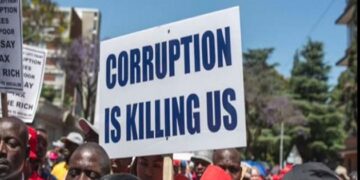Introduction
The twenty-first century has ushered in a new form of political mobilisation, powered by two major forces: the youth bulge and social media activism. Across the globe, from Kathmandu to Nairobi and Dhaka, young people—often referred to as Generation Z—have used digital platforms to amplify grievances, mobilise protests, and challenge entrenched political systems. In Africa, where approximately 60% of the population is under 25, this demographic reality (World Economic Forum, 2024) is becoming a decisive factor in shaping democratic governance. Social media has provided these young citizens not only with a voice but also with organisational power that bypasses traditional political structures. Yet, these movements also present significant security challenges to fragile states.
Youth Bulge and Its Democratic Potential
The youth bulge refers to a disproportionately large population of young people within a country’s demographic structure. According to PopulationPyramid.net (2024), Africa currently hosts over 800 million people under the age of 25. This demographic can be a democratic dividend if harnessed properly through education, job creation, and civic inclusion. Conversely, exclusion, corruption, and unemployment risks turning this energy into a destabilising force.
Historically, demographic pressures have been linked to instability when states fail to channel youthful energies constructively (Urdal, 2006). The Arab Spring of 2011 demonstrated how digitally savvy youth movements can topple entrenched regimes. A decade later, Africa is witnessing a similar generational awakening through the “Kenya Spring.”
Case Studies: Social Media as a Catalyst
Nepal (2025)
In Nepal, Gen Z-led protests erupted after the government attempted to ban social media platforms. Some of the Gen Z protesters were killed by police officers during the peaceful protest. This caused the otherwise peaceful demonstration to quickly spiral into a violent one that saw parliament torched and Prime Minister K.P. Sharma Oli resign. Furthermore, government officials such as the Finance Minister were hounded, partially stripped and thrown into a river. Some police officers also met a similar fate from the marauding Gen Z demonstrators. The youth movement emphasised accountability, transparency, and non-corrupt leadership, insisting their activism was non-violent and rooted in civic engagement. The protests underlined how digital restrictions can spark unrest when youth view such measures as threats to their voice (BBC Nepali, 2025).
Bangladesh (2024)
Still in Asia, Bangladesh, in 2024, witnessed student-led protests that forced long-serving Prime Minister Sheikh Hasina to resign. Sparked by discontent with nepotism in government hiring, the movement demonstrated how social media-enabled youth uprisings are now a global phenomenon (Al Jazeera, 2024).
Kenya (2024)
In Africa, Kenya’s Gen Z protests in June 2024 against the Finance Bill illustrate the political potency of social media activism. Hashtags such as #OccupyParliament and #RejectFinanceBill2024 galvanised nationwide demonstrations, culminating in the torching of parliament and the withdrawal of the bill by President William Ruto (BBC, 2024). The protests showed how TikTok and other platforms provided civic education, emotional mobilisation, and real-time coordination.
Uganda & Nigeria (2024)
Inspired by Kenya, Ugandan youth mobilised under #March2Parliament to demand accountability from Speaker Anita Among, while Nigerians protested against rising living costs and governance failures. Despite repression, these protests underscored how youth activism travels across borders, amplified by digital solidarity networks (VOA, 2024; BBC, 2024).
Dividends and Downsides
The surge of youth-led protests carries both positive democratic impacts and serious security concerns. For starters, youth activism pressures governments to be more accountable, transparent, and responsive. Leaders like Ruto were forced to reconsider unpopular policies due to mass mobilisation. Through such democratic renewal, accountability, transparency and anti-corruption are taken more seriously by the political class since they get awakened and re-sensitised to democratic credentials which are essential to their continued stay in office.
It also offers the political class an opportunity to involve the youth in the governance process by listening to their perspectives on national issues and giving them critical roles to play in officialdom to ensure adequate representation. Such inclusivity is normally rare or non-existent in Africa.
On the other hand, however, such activism can lead to political instability. Spontaneous protests can escalate into riots, vandalism, or regime collapse, creating governance vacuums, as seen in Nepal. Within the same spectrum, opportunists can take advantage of the protests by the youth to be up to no good by instigating or carrying out coups for self-serving purposes. In fragile states, youth disillusionment can be exploited by extremist groups, particularly in regions like the Sahel where governance deficits and militant groups coexist.
Additionally, such activism could spark regional spillovers. Hashtags, live streams, and viral videos allow protests to transcend borders. Kenya’s protests inspired similar activism in Uganda and Nigeria, creating a domino effect of unrest.
In terms of security, governments often respond with militarised crackdowns, curfews, or internet shutdowns, which exacerbate tensions and further alienate the youth.
Conclusion
The youth bulge and social media activism are shaping the trajectory of democratic governance worldwide. In Africa, where the majority of the population is young, governments can no longer afford to ignore the voices of young people. Social media has provided this generation with an uncensored space for civic engagement, but unless their demands for jobs, transparency, and good governance are addressed, the protests risk spiralling into instability.
For states, the challenge is striking a balance between security and order, while respecting democratic freedoms. For youth, the task is ensuring their movements remain peaceful, constructive, and not co-opted by opportunists. Ultimately, the rising wave of youth activism signals that the next phase of governance in Africa—and globally—will be determined not just in parliaments, but also on the digital battlegrounds of TikTok, X, and Instagram.
It, thus, goes without saying that any government or state-sponsored attempt to shut down social media, which has become the main source of entertainment for the youth as well as a platform for freedom of expression on social and political issues, will be met with an outpouring of several years of restrained youthful anger. Governments cannot exclude the youth from national governance and decision-making processes in matters that concern their future, while at the same time denying them the very entertainment platforms that distract and soothe them from the adverse consequences of those decisions.
The youth of any country would act in the same way as their Nepalese counterparts did in any situation where the government fetters or completely shuts down their access to social media. It is a 21st-century taboo to touch social that way – a tactical error which the youth find sacrilegious and unforgivable. Governments must, therefore, realise that even at the risk of death, the youth will fight for their only liberating source of escape and freedom of expression.
References
- BBC News (2024). Kenya finance bill protests: Gen Z protesters torch parliament.
- BBC Nepali (2025). Nepal unrest: Gen Z protests and Oli resignation.
- Voice of America (2024). Ugandan youth march on parliament over corruption.
- Al Jazeera (2024). Bangladesh protests force Sheikh Hasina to resign.
- PopulationPyramid.net (2024). Africa population under 25.
- World Economic Forum (2024). Africa’s youth bulge and its potential.
- Urdal, H. (2006). A Clash of Generations? Youth Bulges and Political Violence. International Studies Quarterly, 50(3).






























